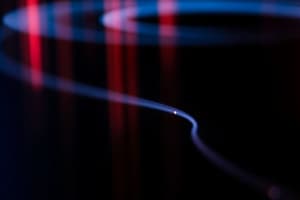Podcast
Questions and Answers
What is the primary purpose of transduction in sensory systems?
What is the primary purpose of transduction in sensory systems?
- To filter out irrelevant sensory information
- To interpret sensory signals into conscious experience
- To transform physical stimuli into neural impulses (correct)
- To enhance the stimulus energy received by the sensory organs
How do bottom-up and top-down processing differ in the context of perception?
How do bottom-up and top-down processing differ in the context of perception?
- Bottom-up processing relies on prior knowledge, while top-down processing does not
- Bottom-up processing starts with sensory input, while top-down processing uses existing knowledge (correct)
- Top-down processing is unconscious while bottom-up processing is conscious
- Both processes result in the same perception outcomes
What does the concept of absolute threshold refer to?
What does the concept of absolute threshold refer to?
- The minimal intensity needed to just barely detect a stimulus (correct)
- The variable intensity of a stimulus perceived by different individuals
- The highest intensity of a stimulus that can be detected
- The average intensity at which stimuli can be perceived
What role does attention play in the process of perception?
What role does attention play in the process of perception?
What does the difference threshold refer to?
What does the difference threshold refer to?
Which of the following best describes the field of psychophysics?
Which of the following best describes the field of psychophysics?
According to Weber's Law, how must two stimuli differ for them to be perceived as different?
According to Weber's Law, how must two stimuli differ for them to be perceived as different?
Why might children perceive different images than adults when looking at vague shapes or forms?
Why might children perceive different images than adults when looking at vague shapes or forms?
Which of the following is an example of how psychophysics relates physical energy to psychological experience?
Which of the following is an example of how psychophysics relates physical energy to psychological experience?
What is sensory adaptation?
What is sensory adaptation?
What is selective attention responsible for?
What is selective attention responsible for?
Which phenomenon illustrates the difference between perception and reality?
Which phenomenon illustrates the difference between perception and reality?
Inattentional blindness occurs when?
Inattentional blindness occurs when?
Change blindness is best described as?
Change blindness is best described as?
What percentage difference is required for perceiving a change in light stimuli according to Weber's Law?
What percentage difference is required for perceiving a change in light stimuli according to Weber's Law?
Which of the following describes the role of our sensory systems?
Which of the following describes the role of our sensory systems?
What determines the perceived brightness of a light wave?
What determines the perceived brightness of a light wave?
How is wavelength defined in terms of a light wave?
How is wavelength defined in terms of a light wave?
Which part of the eye acts as the main lens to focus light?
Which part of the eye acts as the main lens to focus light?
What is the role of the fovea in the visual system?
What is the role of the fovea in the visual system?
What type of visual issue can occur if accommodation is impaired?
What type of visual issue can occur if accommodation is impaired?
What does the trichromatic theory suggest about the eye's cone receptors?
What does the trichromatic theory suggest about the eye's cone receptors?
Which cells are responsible for transmitting visual information from the retina to the brain?
Which cells are responsible for transmitting visual information from the retina to the brain?
What is the function of the optic nerve?
What is the function of the optic nerve?
Which visual pathway is responsible for the identification of objects?
Which visual pathway is responsible for the identification of objects?
What condition describes the inability to recognize objects by sight?
What condition describes the inability to recognize objects by sight?
Which of the following describes the area with no receptor cells in the eye?
Which of the following describes the area with no receptor cells in the eye?
What phenomenon allows us to perceive objects as constant despite changes in lighting?
What phenomenon allows us to perceive objects as constant despite changes in lighting?
Which of the following is a correct definition of depth perception?
Which of the following is a correct definition of depth perception?
What is the role of binocular disparity in depth perception?
What is the role of binocular disparity in depth perception?
Which concept explains our perception of objects being the same size despite distance variation?
Which concept explains our perception of objects being the same size despite distance variation?
How do Gestalt principles impact our perception?
How do Gestalt principles impact our perception?
What does the cue of interposition indicate about two overlapping objects?
What does the cue of interposition indicate about two overlapping objects?
Which cue involves the comparison of sizes to determine distance?
Which cue involves the comparison of sizes to determine distance?
What effect does linear perspective have on the perception of distance?
What effect does linear perspective have on the perception of distance?
How does the relative height cue influence our perception of distance?
How does the relative height cue influence our perception of distance?
What is the relationship between pitch and frequency in sound waves?
What is the relationship between pitch and frequency in sound waves?
What does sound complexity refer to in wave characteristics?
What does sound complexity refer to in wave characteristics?
Which component of the ear amplifies sound vibrations between the eardrum and the cochlea?
Which component of the ear amplifies sound vibrations between the eardrum and the cochlea?
What does intensity in sound waves refer to?
What does intensity in sound waves refer to?
What role does the cochlea play in hearing?
What role does the cochlea play in hearing?
How do large amplitude sound waves affect the basilar membrane?
How do large amplitude sound waves affect the basilar membrane?
What is referred to as sensorineural hearing loss?
What is referred to as sensorineural hearing loss?
What is the primary assumption of the Gate-Control Theory?
What is the primary assumption of the Gate-Control Theory?
Which of the following best describes how the brain perceives pitch using the Place Code?
Which of the following best describes how the brain perceives pitch using the Place Code?
How do intensity differences assist in sound localization?
How do intensity differences assist in sound localization?
What type of sensory receptors provide signals interpreted as pain?
What type of sensory receptors provide signals interpreted as pain?
Which of the following describes the function of hair cells within the cochlea?
Which of the following describes the function of hair cells within the cochlea?
Flashcards
Sensation
Sensation
The process of turning stimulus energy from our senses into neural signals.
Perception
Perception
Organizing, identifying, and interpreting sensory information to create mental images of the world.
Transduction
Transduction
Changing physical energy into neural signals.
Psychophysics
Psychophysics
Signup and view all the flashcards
Absolute Threshold
Absolute Threshold
Signup and view all the flashcards
Bottom-up Processing
Bottom-up Processing
Signup and view all the flashcards
Top-down Processing
Top-down Processing
Signup and view all the flashcards
Stimulus
Stimulus
Signup and view all the flashcards
Difference Threshold
Difference Threshold
Signup and view all the flashcards
Weber's Law
Weber's Law
Signup and view all the flashcards
Sensory Adaptation
Sensory Adaptation
Signup and view all the flashcards
Selective Attention
Selective Attention
Signup and view all the flashcards
Inattentional Blindness
Inattentional Blindness
Signup and view all the flashcards
Change Blindness
Change Blindness
Signup and view all the flashcards
Visible Light
Visible Light
Signup and view all the flashcards
Just Noticeable Difference (JND)
Just Noticeable Difference (JND)
Signup and view all the flashcards
Light Intensity
Light Intensity
Signup and view all the flashcards
Wavelength
Wavelength
Signup and view all the flashcards
Cornea
Cornea
Signup and view all the flashcards
Accommodation
Accommodation
Signup and view all the flashcards
Retina
Retina
Signup and view all the flashcards
Photoreceptors
Photoreceptors
Signup and view all the flashcards
Fovea
Fovea
Signup and view all the flashcards
Optic Nerve
Optic Nerve
Signup and view all the flashcards
Trichromatic Theory
Trichromatic Theory
Signup and view all the flashcards
Visual Form Agnosia
Visual Form Agnosia
Signup and view all the flashcards
Perceptual Constancy
Perceptual Constancy
Signup and view all the flashcards
Lightness Constancy
Lightness Constancy
Signup and view all the flashcards
Binocular Disparity
Binocular Disparity
Signup and view all the flashcards
Gestalt Rules
Gestalt Rules
Signup and view all the flashcards
Depth Perception
Depth Perception
Signup and view all the flashcards
Colour Constancy
Colour Constancy
Signup and view all the flashcards
Interposition
Interposition
Signup and view all the flashcards
Relative Size
Relative Size
Signup and view all the flashcards
Linear Perspective
Linear Perspective
Signup and view all the flashcards
Relative Height
Relative Height
Signup and view all the flashcards
Relative Motion (Motion Parallax)
Relative Motion (Motion Parallax)
Signup and view all the flashcards
Sound Waves
Sound Waves
Signup and view all the flashcards
Sound Intensity
Sound Intensity
Signup and view all the flashcards
Sound Pitch
Sound Pitch
Signup and view all the flashcards
Inner Ear
Inner Ear
Signup and view all the flashcards
Cochlea Function
Cochlea Function
Signup and view all the flashcards
Loudness Perception
Loudness Perception
Signup and view all the flashcards
Hearing Loss Cause
Hearing Loss Cause
Signup and view all the flashcards
Pitch Perception (Place Code)
Pitch Perception (Place Code)
Signup and view all the flashcards
Pitch Perception (Temporal Code)
Pitch Perception (Temporal Code)
Signup and view all the flashcards
Sound Localization
Sound Localization
Signup and view all the flashcards
Nociceptors' Function
Nociceptors' Function
Signup and view all the flashcards




